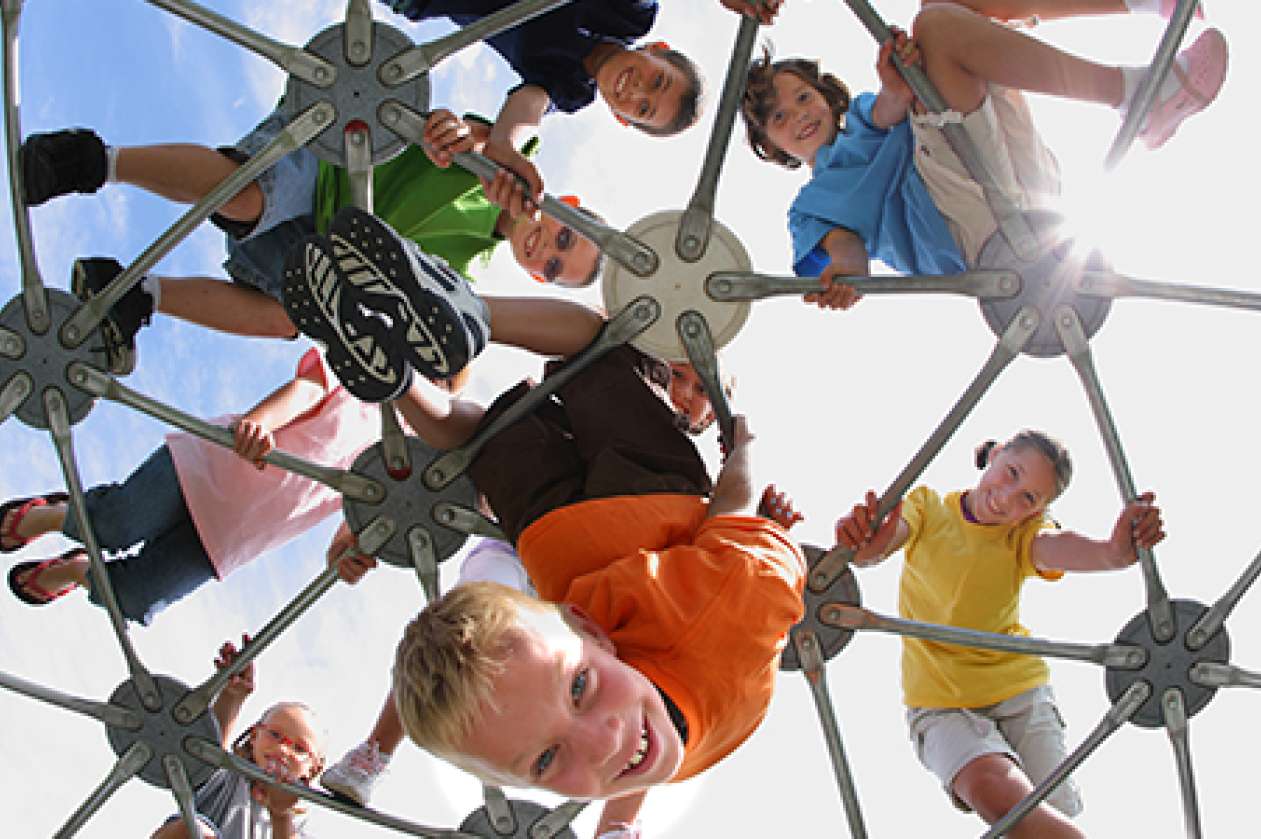
“As safe as necessary”: a new way of looking at risk
The viral story about the father who taught his children to ride the city bus in Vancouver to and from school made headlines not because he taught his children to make the trip independently, but because they’ve since been banned from travelling alone. The B.C. Ministry of Children and Family Development decided that these children were too young to make the trip alone, despite their problem-free commuting prior to the province’s intervention.
While the intention may be to keep these children as safe as possible, it is often these good intentions that ultimately restrict children’s opportunities, minimize their self-perceived abilities, and harm their sense of independence.
While there’s never been a statistically safer time to be a child in Canada, parents and families are constantly being bombarded with messages of fear, and these fears get placed on their children. Canadians have never been safer, but never felt more at risk.
Falling into the “be careful” trap
This feeling of constant threat and jeopardy even impacts how we let our children play. “Not too high,” “Slow down,” “Stay where I can see you,” and “Be careful” are the kinds of phrases we use with kids on the playground and at home.
It’s “Be careful!” that seems to be of particular interest to Dr. Mariana Brussoni, a developmental psychologist and expert in risky play. She explains that if we’re always telling our children to be careful, when there’s no clear or immediate danger and no clear guide as to how you should be careful, it makes children feel like there’s a constant threat.
Think about it: if a child doesn’t know what they’re actually supposed to be careful or afraid of, then everything around them will become vaguely threatening. And it’s this perception of threat and risk that contributes to declining rates of outdoor and risky play, and eventually, a child’s sense of mastery over their well-being, health, and environment.
Dr. Brussoni wants parents to know that they should allow their kids the freedom to play how they choose, even if it means engaging in risky play. What we now call risky play is really just the play that most adults did naturally as children, when it wasn’t considered risky or dangerous.
But, if it’s risk that we’re all afraid of, why call play that takes place up high or outside a parent’s view “risky play”? Why not call it adventurous play or free play?
Dr. Brussoni explains that to call it anything other than risky play avoids the fundamental barrier that prevents children from engaging in this type of play: parents’ fears of risk.
Risk is everywhere and kids need to understand what it is
We need to acknowledge and talk about risk. There is risk involved in everything we do, and risk isn’t a bad thing. It’s a neutral term that describes the likelihood of an outcome. There is risk involved in driving to work, taking a bath, or eating dinner. And there is a normal, fundamental amount of risk in exploring the outdoors, playing where your parents can’t see you, or climbing up into the limbs of a tree. Accepting that there is some inherent risk in play can help parents address their fears and embrace strategies to permit children greater freedom to explore their world.
When it comes to risky play, the benefits far outweigh the risks. Children who are permitted to swing on the monkey bars alone or climb to the top of the jungle gym without a hand ready to brace their fall can get a better sense of their own limits and learn to operate within them. They’ll build confidence in their skills and become more competent movers. Children who play outdoors are likely to spend more time being physically active than when they’re playing inside.
The Position Statement on Active Outdoor Play explains the many other benefits to risky outdoor play. These include: improved socialization with peers, reductions in feelings of isolation, and better interpersonal skills.
There’s no doubt that parents are doing their best to raise healthy, happy children. But sometimes misplaced fears get in the way. The reality is that the majority of playground injuries are minor, and the odds of a child being abducted by a stranger is about 1 in 14 million, according to RCMP data. The odds are much greater that allowing your child to play outside, up high, or out of your sight will create benefits in social, emotional, and physical development.
So, as researchers in this field ask, how can we start to keeps our kids “as safe as necessary” to facilitate their growth and development, rather than “as safe as possible”?
How you can start letting your kids take more risks
To get started in permitting risky play, Dr. Brussoni has a few tips:
- Get off your private property! (That’s right. Get off your own property.) Get outside, go out of the yard, explore your neighborhood and your community.
- Expose your child to playing in natural environments to let their imaginations work; play in places where a tree can be home base, a rocket ship, a climbing structure, or a hiding place.
- Link up with other parents and families in the community to create play networks.
- Don’t hover around children on play equipment if they’re capable of playing independently or bombard children with messages of threat or fear when there’s nothing to be immediately fearful of.
- When children are playing, count to 30 before inserting yourself to allow your child to navigate the situation first and try to problem solve independently.
- Families should also get kids used to playing outside in all types of weather conditions. Rain or snow shouldn’t keep you inside and getting dirty shouldn’t be a bad thing.
- Maintain common sense approaches to safety in play, but recognize that keeping a child “as safe as possible” can come at a cost to their personal growth and development.
- When you want to say, “Be careful”, ask yourself, “What is the threat that I’m afraid of?” If there actually is a real threat, ask yourself if the need to tell your child that there is something threatening outweighs your desire that she or he is an active, healthy, and well-socialized kid.
What are some of the ways you allow your child to explore their surroundings or test their limits? How did you engage in risky play when you were a child? Add your risky play ideas or experiences to the comments section below!






I live on an acreage, sticks and digging in the dirt and mud are an everyday occurrence. They are often finding bugs or worms and building homes for them.
My tree in the front yard is perfect for climbing. Someone is in it whenever we are outside. My playset has them taking risks by jumping out of the swings and hanging upside down from the bars.
I’ve learned that my 3 yr olds are able to evaluate risk quite easily and focus on finding solutions quickly if I allow them the opportunity to do so. The exploration, assessment, and finalization of the activities they choose is not only fun to watch, but also very fulfilling for them.
Many of my favorite memories from my childhood revolve around playing outside – splashing in puddles, digging in dirt in the family garden after harvest, playing in the snowmen building mountains to climb on and slide down. Fortunately my parents did not care how wet or dirty we got as long as we were in play clothes!
My neighbor had several tall arborvitae trees that created on opening “wooded” area in the middle. With her permission we pretended it was our camping site or in the woods. The kids collected leaves and sticks to use as walking sticks on hikes, built a pretend firepit, craft ideas or to dig in the dirt area for bugs, etc. They climbed the trees to lookout for birds that were singing to us, preditors, or what was coming up on their next “adventure”. My daughter slipped once, hanging upside down by her pants. I coaxed her into grabbing branches to turn herself upright and disconnect her caught clothing. I had to do some minor first aid as she ended up having a 1 1/12 inch scrape on her butt. After all that, we all just laughed and talked about how she thinks she lost her balance. It turns out a branch she went to step on broke, causing her to fall a bit.
For me crowing up, the park up the street had a super tall metal slide and a slippery merry-go-round, that we loved playing on. We also played in the rain puddles. We got to ride around town on our bikes. My siblings road their bikes to a pond outside of town to go swimming, not me, I liked our local community pool – LOL
My son sent me a video of my grandson who is 3 trying to climb up a slide and in the video my son just used his hand and told his son to put his foot where his hand was and after my son telling him twice my grandson got the hang of climbing up the slide I was so proud of him
That’s so great to hear, Bonnie! We would be proud, too!
My neighbors who were also my cousins always played together, they had this arch style monkey bars and we would flip it over and ride on it like a teeter totter. It was the highest, coolest and most dangerous teeter totter ever. One of my best memories of childhood, no one ever got more than a bruise from it. So glad our parents let us make those memories!
My grandson isn’t even three yet, but his parents allow him to play and explore in the outdoors all the time. He is very active and loves to run, jump and play. He has a balance bike that has no pedals. A few weeks ago, I was walking with him along the rough, gravel road at the cottage. He was on his bike. We came to a very steep hill that we had to go down. He stopped at the top, walked his bike most of the way down, and then got back on his bike and coasted down the last bit of the hill. His confidence from previous experiences allowed him to assess the situation and decide on the best plan of action. I like that I didn’t have to say anything to him, and avoided saying, Be careful!”